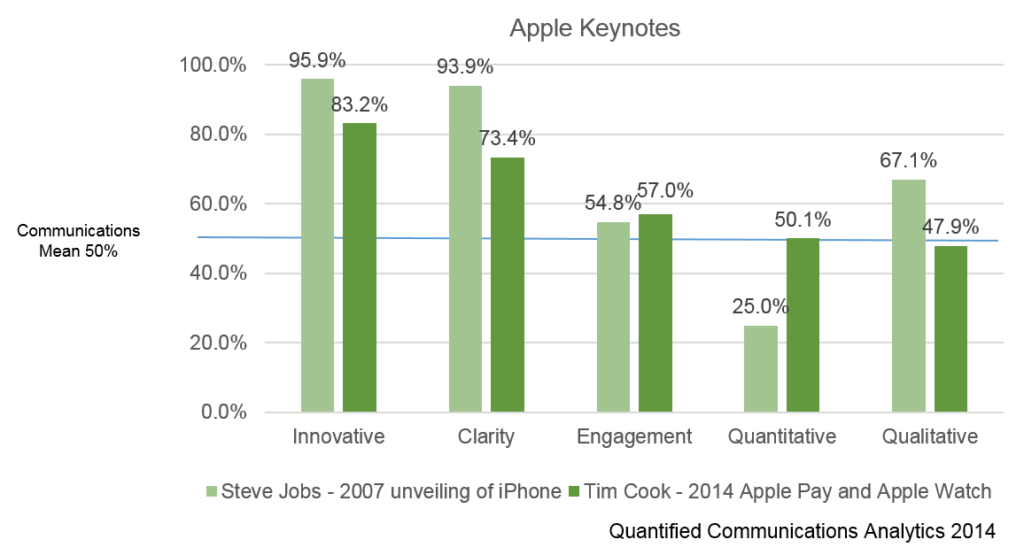Did Tim Cook finally deliver an exciting presentation? Quantifying the Apple Watch Presentation vs. Steve Jobs’ iPhone Presentation

September 9, 2014
When Apple releases new software updates or new products, the company stages a special event to explain – and hype – the new features. In order to build excitement around the new releases, which have been shrouded in secrecy as they are developed, the company drops hints along the way before chief executives deliver keynote speeches on stage to a live audience, as well as to anyone watching online.
During such an event in 2007, then CEO of Apple, Steve Jobs, unveiled the iPhone to the world. In this historic moment for the company, Steve Jobs described an innovative product in a way that had people lining up to get their hands on it. He set a benchmark for showmanship that few CEOs have been able to master.
This afternoon, Tim Cook gave a similar speech unveiling Apple Pay and the Apple Watch. Was he able to elicit the same excitement around the Apple Watch (in spite of some embarrassing technical glitches in the live streaming of the event) that Steve Jobs built around the iPhone?
To find out, we used our natural language processing and linguistic mapping tools to analyze the language from the 2007 launch of the iPhone versus the 2014 unveiling of the Apple Watch. We then benchmarked the results against our communications database containing over 100,000 communicators (including corporate keynotes, TED talks, commencement speeches, and others).
Tim Cook’s 2014 keynote was very similar to the 2007 address from Steve Jobs. He even borrowed now iconic lines from Jobs, such as “One more thing…” to help build suspense. Both CEOs used more innovative language than the database average, spoke clearly, and used similar levels of engaging language.
What our analysis revealed, however, is the type of supporting material each CEO seemed to prefer. Tim Cook used 24.9% more quantitative material (numbers, statistics) than Steve Jobs to support his main points. Likewise, Steve Jobs used 19.2% more qualitative material (stories, quotes, etc.) than Tim Cook to support his points.
This is apparent throughout each speech. Tim Cook made statements such as:
Every day, between credit and debit, we spend 12 billion dollars. That’s over four trillion dollars a year and that’s just in the United States. And this business is comprised of over 200 million transactions a day. That’s 200 million times that we scramble for our credit cards and go through what is a fairly antiquated payment process.
However, Steve Jobs used stories to help his audience relate to and understand the thought process behind the new products:
They all have these keyboards that are there whether or not you need them to be there. And they all have these control buttons that are fixed in plastic and are the same for every application. Well, every application wants a slightly different user interface, a slightly optimized set of buttons, just for it. And what happens if you think of a great idea six months from now? You can’t run around and add a button to these things. They’re already shipped. So what do you do? It doesn’t work because the buttons and the controls can’t change. They can’t change for each application, and they can’t change down the road if you think of another great idea you want to add to this product.
Well, how do you solve this? Hmm. It turns out, we have solved it!
Our analysis demonstrates how great communicators can also be authentic in their approach. Steve Jobs is best in class for innovative and clear language. Tim Cook strikes a better balance between quantitative and qualitative supporting materials in his presentation, and he thus actually outperforms Mr. Jobs on audience engagement. Whether the Apple Watch will rival the iPhone in popularity remains to be seen. But we can learn from observing the way such different but effective communicators have engaged the public with an iconic American technology company.
